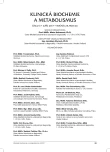„Normal“ laboratory finding
Authors:
M. Kalousová
Authors‘ workplace:
Ústav lékařské biochemie a laboratorní diagnostiky, 1. lékařská fakulta, Univerzita Karlova a Všeobecná
fakultní nemocnice v Praze
Published in:
Klin. Biochem. Metab., 25, 2017, No. 3, p. 92-95
Overview
Laboratory examinations are part of the diagnostic-therapeutic process. They play an important role in the decision how to proceed in acute and chronic diseases and in their monitoring. Obvious changes can be seen in organ damage, and generally, the more severe the damage, the more expressed are the changes. On the other hand, there are also cases when the patient is not feeling well but the results are so called normal or almost “normal”, i.e. correctly described in the reference range. The aim of the work was to consider what the results in reference ranges can mean. Reference range contains 95 % of population, i.e. 5 % of healthy subjects will have results out of this range and will be false positive. On contrary, some patients can have results in this range and be false negative. A patient who is not feeling well but the changes in the laboratory results are only discrete if any (everything in reference range or boundary results) is not necessarily healthy. Laboratory results have to be interpreted individually in line with the case history, clinical state and results of other examinations. Trends should be followed up as well. These patients may represent just a minority but they should deserve attention.
Keywords:
biomarker, false negative, false positive, reference interval
Sources
1. Racek, J. et al. Klinická biochemie. 2. přepracované vydání. Praha: Galén, 2006, 329 s.
2. http://www.who.int/about/mission/en/
3. Zima, T. Laboratorní diagnostika. Třetí doplněné a přepracované vydání. Praha: Galén, 2013, 1146 s.
4. Zima, T., Racek, J., Tesař, V., Viklický, O., Teplan, V., Schück, O., Janda, J., Friedecký, B., Kubíček, Z., Kratochvíla, J., Rajdl, D., Šálek, T., Kalousová, M., Granátová, J. Doporučení k diagnostice chronického onemocnění ledvin (odhad glomerulární filtrace a vyšetřování proteinurie) České nefrologické společnosti ČLS JEP a České společnosti klinické biochemie ČLS JEP. Klin. Biochem. Metab., 2014, 22 (43), 3, p. 138-152.
5. Valík, D., Nekulová, M., Zdražilová, Dubská, L., Springer, D., Malbohan, I., Zima, T., Topolčan, O., Fuchsová, R., Svobodová, Š. Doporučení k využití nádorových markerů v klinické praxi. Klin. Biochem. Metab., 2014, 22 (43), 1, p. 22-39.
6. Friedecký, B., Jabor, A., Kratochvíla, J., Rajdl, D., Kettner, J., Franeková, J., Janota, T., Pudil, R., Hnátek, T., Rokyta, R. Doporučení ČSKB: Používání kardiálních troponinů při podezření na akutní koronární syndrom. Klin. Biochem. Metab., 2015, 23 (44), 2, p. 71-77.
7. Viklický, O., Tesař, V., Dusilová-Sulková, S. Doporučené postupy a algoritmy v nefrologii. Praha: Grada, 2010, 192 s.
8. Thomas, L. Labor und Diagnose. Indikation und Bewertung von Laborbefunden für die medizinische Diagnostik. 8. Auflage. Frankfurt, Germany: TH-Books, 2012, 2360 s.
9. Mrázová, K., Zeman, D., Bořecká, K., Ženková, J., Brož, P., Mareš, J., Hanzalová, J., Král, V., Krbková, L. Doporučení k vyšetřování mozkomíšního moku. Klin. Biochem. Metab., 2017, 25 (46), 1, p. 43–47.
10. Fialová, L. Návody k praktickým cvičením z lékařské chemie a biochemie s klinicko-biochemickými aplikacemi. Praha: Medprint, 2003, 185 s.
Labels
Clinical biochemistry Nuclear medicine Nutritive therapistArticle was published in
Clinical Biochemistry and Metabolism

2017 Issue 3
Most read in this issue
- „Normal“ laboratory finding
- Therapeutic monoclonal antibodies in clinical laboratory
- Congenital disorders of glycosylation: alpha-dystroglycanopathies
- Determination of albumin in serum and plasma. Harmonization of results and clinical recommendations in patients with renal diseases.
